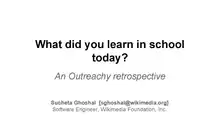Outreach
Outreach is the activity of providing services to any population that might not otherwise have access to those services.[1][2] A key component of outreach is that the group providing it is not stationary, but mobile; in other words, it involves meeting someone in need of an outreach service at the location where they are.[1][2][3] Compared with traditional service providers, outreach services are provided closer to where people may reside, efforts are very often voluntary, and have fewer, if any, enforceable obligations. In addition to delivering services, outreach has an educational role, raising the awareness of existing services.[3] It includes identification of under-served populations and service referral and the use of outreach tools like leaflets, newsletters, advertising stalls and displays, and dedicated events. Outreach is often meant to fill in the gap in the services provided by mainstream (often governmental) services, and is often carried out by non-profit, nongovernmental organizations.[1]

Categories
There are many different types of outreach, but they can be categorized into these four groupings: domiciliary (undertaken at individual homes), detached (undertaken in public environments and targeting individuals), peripatetic (undertaken at public or private environments and targeting organizations rather than individuals).[4] and satellite outreach (where services are provided at a dedicated site).[3]
Homeless Street Outreach
The concept of street outreach to folks that are experiencing homelessness is a classic example of a form of outreach. There are multiple governmental and non-governmental agencies that have sought to engage in this work because of the understanding that unhoused people tend to have increased barriers to access traditional services. Street outreach comes in different forms, from people walking around carrying supplies or offering resources, to mobile health clinics with teams of medical volunteers driving around and offering services. Regardless of its form, the essence of street outreach is the desire to meet people where they are at, build deep trust and connections, offer support, and reinforce the human dignity and respect that is deserving of all people.[5] The core elements of effective street outreach include being systematic, coordinated, comprehensive, housing-focused, person-centered, trauma-informed, culturally responsive, as well as emphasizing safety and reducing harm.[6]
Housing First Model
Going hand in hand with street outreach is the Housing First Model. It is often the state provision towards homeless street outreach because it gives tangible results, gets people off the streets, and is overall beneficial for a cities economy. Government officials that perform street outreach with the Housing First Model in mind can sometimes be faced with backlash because these outreach services can be seen as a way for the government to expand control over a previously hard to govern group, or a method by which unhoused community members are pushed out of sight for the benefit of their housed counterparts.[7][8]
Territory
Issues surrounding territory, respect, and understanding regarding the homes of the unsheltered when engaging in homeless service outreach is often a factor that is considered by outreach workers. Volunteers aim to affirm the territories of those that are unsheltered by acts of respect for privacy (including asking for permission to enter a person's space, knocking on the frame of the tent to notify residents about potentially entering the homes of the unsheltered).[9] Instead of coming from a place of governance and regulation that often results of Housing First centered street outreach, community outreach by volunteers are often focused on giving dignity and respect to the unhoused.
References
- Kate Hardy; Sarah Kingston; Teela Sanders (16 December 2010). New Sociologies of Sex Work. Ashgate Publishing, Ltd. p. 77. ISBN 978-0-7546-7986-8. Retrieved 16 September 2012.
- Legal Services Research Centre (30 March 2009). Reaching Further: Innovation, Access and Quality in Legal Services. The Stationery Office. pp. 73–74. ISBN 978-0-11-706724-0. Retrieved 17 September 2012.
- "Maximising the Role of Outreach in Client Engagement", Dewson S, Davis S, Casebourne J. Research Report DWPRR 326, Department for Work and Pensions, 2006.
- Tim Rhodes (1996). Outreach Work with Drug Users: Principles and Practice. Council of Europe. pp. 25–26. ISBN 978-92-871-3110-2. Retrieved 17 September 2012.
- Olivet, Jeffrey; Bassuk, Ellen; Elstad, Emily; Kenney, Rachael; Jassil, Lauren (2010-04-07). "Outreach and Engagement in Homeless Services: A Review of the Literature~!2009-08-18~!2009-09-28~!2010-03-22~!". The Open Health Services and Policy Journal. 3 (2): 53–70. doi:10.2174/1874924001003020053. ISSN 1874-9240.
- "State Interagency Council to End Homelessness and Interagency Council on Hunger and Homelessness: Executive Order No. 06-05". PsycEXTRA Dataset. 2006. Retrieved 2021-01-08.
- Clarke, Andrew; Parsell, Cameron (2020-08-18). "The Ambiguities of Homelessness Governance: Disentangling Care and Revanchism in the Neoliberalising City". Antipode. 52 (6): 1624–1646. doi:10.1111/anti.12671. ISSN 0066-4812.
- Baker, Tom; Evans, Joshua (2016). "'Housing First' and the Changing Terrains of Homeless Governance". Geography Compass. 10 (1): 25–41. doi:10.1111/gec3.12257. ISSN 1749-8198.
- Smith, Robin James; Hall, Tom (2017-07-18). "Everyday territories: homelessness, outreach work and city space". The British Journal of Sociology. 69 (2): 372–390. doi:10.1111/1468-4446.12280. ISSN 0007-1315.
External links
![]() Media related to Outreach at Wikimedia Commons
Media related to Outreach at Wikimedia Commons
